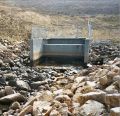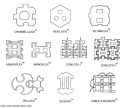Riprap and Concrete Blocks Examples: Difference between revisions
(Created page with "<!--Example Page --> <div style= "text-align:center;"> <!-- Add message here --> ''Message: Examples of Riprap and Concrete Block Basins'' </div> ----</br> <!-- Add body paragraphs here --> The riprap apron is one of the most common forms of outlet protection on small dams. The riprap apron is typically a flared transition constructed at zero grade for a distance downstream that is related to the conduit diameter. Although the riprap apron provides relatively little ener...") |
No edit summary |
||
| Line 26: | Line 26: | ||
</gallery> | </gallery> | ||
''Note: The content on this page was originally created as part of DamOutletWorks.org (DOWL, 2018). It has subsequently been updated and reformatted as part of the Dam Safety Toolbox.'' | |||
[[Category:Example Pages]] | [[Category:Example Pages]] | ||
{{Revhistinf}} | {{Revhistinf}} | ||
Revision as of 20:57, 15 September 2022
Message: Examples of Riprap and Concrete Block Basins
The riprap apron is one of the most common forms of outlet protection on small dams. The riprap apron is typically a flared transition constructed at zero grade for a distance downstream that is related to the conduit diameter. Although the riprap apron provides relatively little energy dissipation, it can provide very effective erosion protection at the conduit outlet by armoring the turbulent transition area. The key design parameters of the riprap apron are apron length, apron width, riprap thickness, and riprap size.
Note: The content on this page was originally created as part of DamOutletWorks.org (DOWL, 2018). It has subsequently been updated and reformatted as part of the Dam Safety Toolbox.
Revision ID: 3215
Revision Date: 09/15/2022













